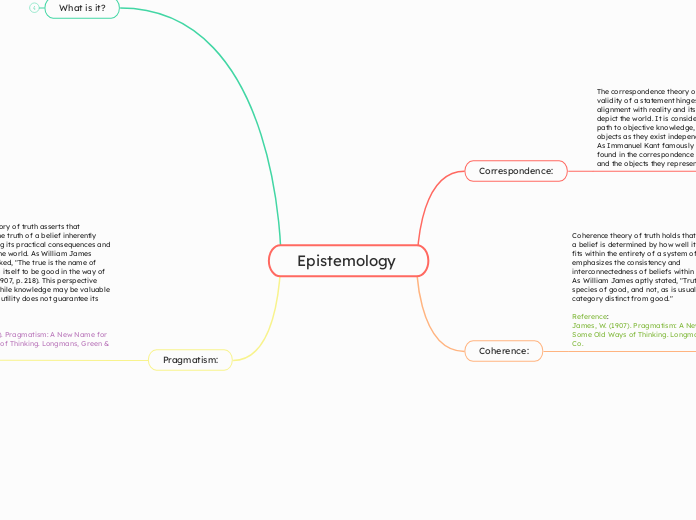Epistemology
What is it?
Correspondence:
The correspondence theory of truth asserts that the validity of a statement hinges solely on its alignment with reality and its ability to accurately depict the world. It is considered the most direct path to objective knowledge, offering insight into objects as they exist independently of perception. As Immanuel Kant famously remarked, "Truth is found in the correspondence between our concepts and the objects they represent."
Example:In a courtroom, a witness testifies that they saw the defendant at the scene of the crime. According to the correspondence theory of truth, the statement is considered true if it accurately aligns with the reality of the defendant's presence at the crime scene. If indeed the defendant was present there, the statement corresponds to that fact and is true. Conversely, if the defendant was not present at the scene, the statement would not correspond to reality and would be false. Thus, the truthfulness of the statement is determined by its correspondence with the actual state of affairs, reflecting the essence of the correspondence theory of truth.
Example:In a courtroom, a witness testifies that they saw the defendant at the scene of the crime. According to the correspondence theory of truth, the statement is considered true if it accurately aligns with the reality of the defendant's presence at the crime scene. If indeed the defendant was present there, the statement corresponds to that fact and is true. Conversely, if the defendant was not present at the scene, the statement would not correspond to reality and would be false. Thus, the truthfulness of the statement is determined by its correspondence with the actual state of affairs, reflecting the essence of the correspondence theory of truth.
Coherence:
Coherence theory of truth holds that the validity of a belief is determined by how well it harmonizes or fits within the entirety of a system of beliefs. It emphasizes the consistency and interconnectedness of beliefs within a framework. As William James aptly stated, "Truth is one species of good, and not, as is usually supposed, a category distinct from good."
Reference:
James, W. (1907). Pragmatism: A New Name for Some Old Ways of Thinking. Longmans, Green & Co.
Example:When Charles Darwin first proposed his theory of evolution by natural selection in the 19th century, it was met with skepticism and disbelief by many people. Some believed it was just a hypothesis or a false notion. However, as scientific evidence accumulated over time, demonstrating the processes of natural selection and providing fossil records supporting evolutionary changes, more and more people came to accept evolution as a valid scientific theory. Eventually, it became widely accepted as the prevailing explanation for the diversity of life on Earth. Thus, what initially may have been regarded as a controversial or doubted idea gradually became recognized as a fundamental truth in the scientific community and beyond.
Example:Another example is the heliocentric model of the solar system proposed by Nicolaus Copernicus in the 16th century. Initially, the prevailing belief was in the geocentric model, which placed Earth at the center of the universe. Copernicus's heliocentric model, with the Sun at the center and the planets orbiting around it, challenged this established view. Many people resisted this new idea, considering it radical and heretical. However, as observational evidence accumulated and the heliocentric model provided a more accurate explanation of planetary motion, it gradually gained acceptance. Eventually, Copernicus's heliocentric theory became the widely accepted scientific model of the solar system, displacing the geocentric view and revolutionizing our understanding of the cosmos.
Pragmatism:
A pragmatic theory of truth asserts that understanding the truth of a belief inherently involves grasping its practical consequences and implications in the world. As William James famously remarked, "The true is the name of whatever proves itself to be good in the way of belief" (James, 1907, p. 218). This perspective highlights that while knowledge may be valuable and relevant, its utility does not guarantee its accuracy.
Reference:
James, W. (1907). Pragmatism: A New Name for Some Old Ways of Thinking. Longmans, Green & Co.
Example:Suppose you're at a restaurant with a friend, and the food arrives, but it's too spicy for your liking. You turn to your friend and say, "Pass me the water, please. I'm on fire!"
In this situation, your statement demonstrates pragmatism in action. Literally interpreting "on fire" would imply you are physically engulfed in flames, which is clearly not the case. Instead, through contextual understanding and shared knowledge, your friend infers that you mean you're experiencing discomfort due to the spiciness of the food. Thus, they pass you the water to alleviate the sensation of heat, demonstrating how pragmatic interpretation relies on practical understanding rather than literal meanings.
Example:Imagine you're working on a group project with your colleagues, and one of them says, "Let's brainstorm some ideas for the presentation tomorrow. We need to knock it out of the park!"
In this scenario, the phrase "knock it out of the park" is an example of pragmatism in real life. Literally interpreting this phrase would suggest physically hitting a presentation with a baseball bat, which obviously doesn't make sense in this context. Instead, based on shared knowledge and understanding of idiomatic expressions, the team infers that it means coming up with outstanding ideas to impress the audience during the presentation. So, they engage in creative brainstorming to meet the intended goal, demonstrating how pragmatic interpretation relies on contextual understanding.
